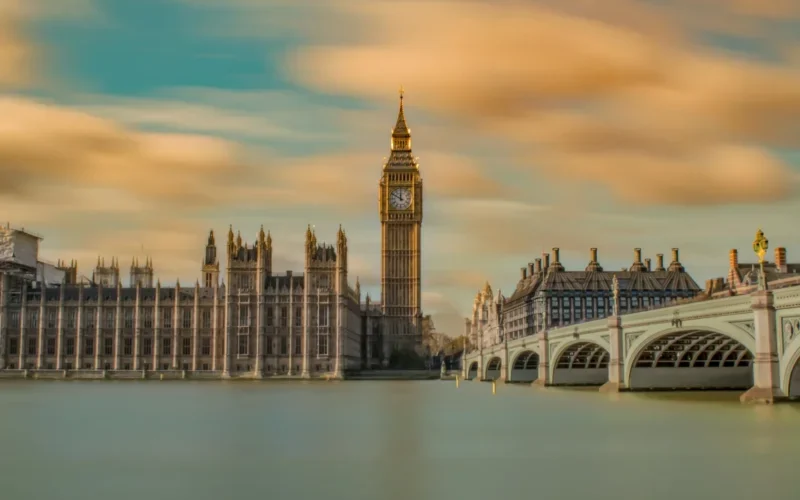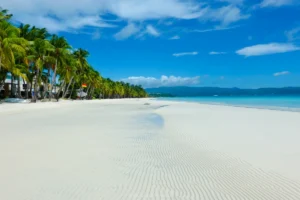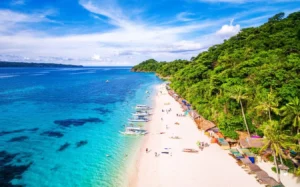Introduction to Lake Baikal
Lake Baikal, located in the southern region of Siberia, Russia, is a remarkable natural wonder that captivates travelers and photographers from around the globe. Known for its staggering beauty and ecological significance, Lake Baikal holds the title as the world’s deepest and oldest freshwater lake, plunging to depths of 1,642 meters (5,387 feet) and estimated to be over 25 million years old. Its pristine waters, expansive ice formations, and diverse flora and fauna make it a UNESCO World Heritage Site, a testament to its outstanding universal value.
This majestic lake spans an impressive 31,722 square kilometers (12,248 square miles) and holds around 20% of the world’s unfrozen fresh surface water. Its crystal-clear waters offer visibility up to 40 meters (131 feet) deep, providing an unparalleled spectacle for divers, nature enthusiasts, and photographers seeking to capture its ethereal charm. The surrounding landscape, consisting of towering mountain ranges and lush taiga forests, further enhances its allure, making it a prime destination for those eager to experience the unspoiled wilderness of Russia.
Beyond its geographical and ecological marvels, Lake Baikal is revered for its cultural significance and historical richness. Numerous indigenous communities, including the Buryats, reside along its shores, contributing to the vibrant cultural mosaic of the region. The lake’s mystical presence is deeply ingrained in local folklore and traditions, adding a layer of spiritual depth to its natural splendor.
The opportunity to explore Lake Baikal’s unique features, from its frozen winter landscapes to its summertime biodiversity, combined with the chance to capture stunning photographs, explains its growing popularity among travel enthusiasts. Its blend of untouched natural beauty and profound cultural heritage positions Lake Baikal as an unparalleled destination, inviting those who visit to discover the hidden treasures of this Russian gem.
Historical Architecture Around Lake Baikal
Lake Baikal, the world’s deepest freshwater lake, is not only a geographical marvel but also a reservoir of historical architecture, reflecting a rich tapestry of cultures and heritage. The shores of Lake Baikal are dotted with ancient churches, traditional wooden houses, and remnants of old settlements that encapsulate the essence of a bygone era. These structures tell the stories of the local communities who have lived and thrived around the lake for centuries.
The architectural landscape around Lake Baikal reveals a remarkable blend of styles, influenced by Russian, Mongolian, and Buryat heritage. One of the most prominent features are the ancient Orthodox churches, such as the St. Nicholas Church, which showcase ornate wooden carvings and intricate iconography. These churches are a testament to the deeply rooted religious traditions and community spirit that have endured through generations.
In addition to ecclesiastical architecture, the traditional wooden houses known as “izbas” provide a glimpse into the everyday lives of the people who have called this region home. These log cabins, characterized by their unique construction techniques and decorative woodwork, exemplify the pragmatic yet artistic approach to building in a harsh, Siberian climate. The izbas often feature beautifully carved window frames and gabled roofs, reflecting the craftsmanship and aesthetic sensibilities of their builders.
Further enriching the architectural tapestry are the remnants of old settlements, which include ancient fortresses and trading posts. These structures provide invaluable insights into the region’s historical trade routes and strategic importance, especially during periods of Mongolian and Buryat influence. The interplay of different architectural styles symbolizes the cultural exchange and diverse influences that have shaped the communities around Lake Baikal.
Overall, the historical architecture around Lake Baikal not only enhances its scenic beauty but also stands as a monument to the cultural and historical narratives that have unfolded around this iconic body of water. Exploring these architectural treasures allows visitors to connect with the rich heritage and stories that make Lake Baikal a truly captivating destination.
Krestovaya Pad Church, located near the shores of the majestic Lake Baikal, is one of the most iconic architectural gems in the region. This church, with its stunning design and historical significance, attracts architecture enthusiasts and photographers from all over the world. Constructed in the classic Siberian style, Krestovaya Pad Church is distinguished by its wooden structure, intricately carved details, and vibrant, colorful facades that harmoniously blend with the natural surroundings.
The historical importance of Krestovaya Pad Church is deeply intertwined with the cultural heritage of the area. It was built in the late 19th century and has since stood as a testament to the endurance of local craftsmanship and religious devotion. The church has weathered numerous changes over the decades, reflecting the resilience of its community. Its altarpiece, icons, and frescoes contribute to a rich visual narrative that captures the spiritual legacy of rural Russia.
For photographers, Krestovaya Pad Church offers a myriad of opportunities to capture the essence of Lake Baikal’s rustic charm. The best time to visit is during the golden hours of early morning or late afternoon when the sunlight casts a warm glow on the church’s wooden frame, highlighting its detailed architecture. Winter, with its blanket of snow, provides a stark contrast that accentuates the church’s vibrant colors, making it an exceptional backdrop against the frozen landscape of Lake Baikal. The autumn season, with its golden leaves, also offers a picturesque setting that enhances the rustic allure of the church.
Whether you are an architecture enthusiast or a passionate photographer, Krestovaya Pad Church is undoubtedly a must-visit spot near Lake Baikal. Its architectural beauty, enriched by a profound historical background, makes it a prime location for capturing timeless images that embody the spirit of this remarkable region.
Modern Architectural Marvels: Baikal Museum
Lake Baikal, renowned for its pristine waters and diverse ecosystem, also hosts some impressive modern architectural structures. Among these, the Baikal Museum stands out as a significant point of interest. The museum’s contemporary design seamlessly blends with the natural landscape, offering an architectural marvel that captivates visitors even before they venture inside.
The Baikal Museum features a distinctive design, blending clean lines and expansive glass facades that create a transparent and open atmosphere. This modern aesthetic not only provides an inviting entrance but also allows natural light to flood the interior, enhancing the visual experience of the exhibits. The exterior is adorned with materials that reflect the lake’s icy surface, giving a harmonious blend of man-made and natural beauty.
Inside, the museum is divided into various sections that comprehensively cover the lake’s ecosystem and cultural heritage. Exhibits include detailed displays on the unique flora and fauna of Lake Baikal, interactive installations, and immersive multimedia presentations. One of the most popular attractions is the aquarium housing endemic species, such as the Baikal seal, offering visitors an up-close view of the lake’s aquatic life.
For photography enthusiasts, the Baikal Museum provides numerous opportunities to capture both its architectural and natural beauty. The museum’s exterior, with its reflective surfaces and integration with the surrounding environment, makes for striking photographs, especially during sunrise or sunset when the light plays off the glass facades. Inside, the well-lit exhibits and spacious design allow for clear and vibrant shots. When photographing interiors, using a wide-angle lens can help capture the comprehensive layout and intricate details of the exhibits, while a macro lens is ideal for close-up shots of smaller displays or individual species in the aquariums.
Overall, the Baikal Museum is not just a repository of knowledge but a testament to modern architectural ingenuity that enhances the natural wonders of Lake Baikal. Whether you are an architecture enthusiast, a nature lover, or a keen photographer, the museum offers a rich and engaging experience worth documenting.
Nature’s Architecture: Ice Sculptures and Formations
Lake Baikal during winter transforms into a mesmerizing wonderland, offering natural architectural wonders that captivate every visitor. As temperatures plunge, the lake’s surface morphs into an intricate landscape of ice sculptures and formations. The clear ice of Lake Baikal is renowned worldwide for its purity and extraordinary transparency, providing a stark clarity that reveals underwater vistas as if peering through glass.
One of the most striking phenomena at Lake Baikal is the appearance of methane bubbles trapped beneath the ice. These bubbles, formed from organic matter decomposing on the lakebed, freeze in layers as they rise toward the surface, creating ethereal white patterns that resemble miniature constellations. This phenomenon is especially visible in spots like the Kharantsy Islands and around Cape Khoboy on Olkhon Island, where the ice is incredibly thick and clear.
The lake’s ice not only captivates with its clarity and methane bubbles but also produces stunning blue ice hummocks. These massive blocks break off from the main ice sheet and become reshaped by the wind and temperature fluctuations, standing as monumental sculptures that color the horizon in vivid shades of blue. The contrast between the ice and the backdrop of snow-covered mountains makes these hummocks a photographer’s paradise.
To capture these seasonal marvels, visiting Lake Baikal between late January and early March is ideal. During this period, the ice is at its thickest and most transparent, creating optimal conditions for witnessing and photographing these unique natural phenomena. Olkhon Island is highly recommended for its diverse ice formations and relatively mild weather compared to other parts of the lake. For safety, it’s essential to travel with local guides familiar with the terrain, ensuring an enriching and secure experience.
In summary, the architectural beauty of Lake Baikal’s ice formations provides a stunning display of nature’s ingenuity. The clear ice, methane bubble patterns, and blue ice hummocks combine to create a landscape that is as surreal as it is photogenic. Whether you are an avid photographer or simply an aficionado of natural wonders, the frozen vistas of Lake Baikal in winter offer unparalleled visual experiences.
Best Photography Spots: Olkhon Island
Olkhon Island stands as one of the most captivating spots for photography around Lake Baikal. Encompassing an area of 730 square kilometers, this island is renowned for its diverse landscapes, which range from rugged cliffs and serene beaches to dense forests and picturesque steppes. One of the island’s most iconic landmarks is Shamanka Rock, a sacred site believed to have spiritual significance by the indigenous Buryat people. This natural splendor offers photographers a rare opportunity to capture both awe-inspiring landscapes and cultural heritage in a single frame.
With its dramatic cliffs offering sweeping views of Lake Baikal, Olkhon Island provides numerous vantage points for photographers. The island’s western shore, particularly Cape Burkhan near Shamanka Rock, is especially popular for its stunning sunsets and ethereal morning mist. Nearby, Khoboy Cape, the northernmost point of the island, presents another must-see location, with panoramic views that stretch across the vast expanse of the lake. The island’s beaches, such as Sarayskiy Beach, offer a contrasting yet equally breathtaking setting, with their golden sands meeting the crystal-clear waters of Lake Baikal.
Practical tips for photographers planning a visit to Olkhon Island include considerations on equipment and timing. A versatile camera with a wide-angle lens is essential to capture the expansive landscapes, while a tripod can help stabilize shots, especially during early morning or late evening when lighting conditions can be challenging. The best seasons to visit are late spring to early autumn, though winter brings its own unique beauty with the lake’s frozen surface creating otherworldly ice formations. Early mornings and late afternoons provide the most flattering natural light, ideal for highlighting the island’s rugged features and verdant scenery.
Reaching Olkhon Island involves a combination of land and water travel. From Irkutsk, a three-to-four hour drive followed by a short ferry ride brings visitors to this photographic paradise. While the journey may be lengthy, the rich photographic rewards awaiting on Olkhon Island justify every moment of the trip.
Seasonal Photography Guide
Lake Baikal, the world’s deepest and oldest freshwater lake, transforms dramatically with each season, presenting diverse photography opportunities throughout the year. Understanding these seasonal nuances can significantly enhance your photographic endeavors at this natural wonder.
In spring, Lake Baikal emerges from winter’s icy grip. The shores come alive with blossoming flora, and the thawing ice creates ethereal patterns on the lake’s surface. Early morning light is softer and perfect for capturing the subtle colors of new growth. It’s an ideal time to photograph the contrast between lingering ice and budding life, though pathways can sometimes be muddy due to melting snow, so appropriate footwear is advisable.
Summer at Lake Baikal is characterized by vibrant greens and clear blue skies, offering a breathtaking backdrop for landscape photography. The longer daylight hours provide ample shooting opportunities. During this season, you’ll have easy access to various parts of the lake, making it a prime time for capturing wide vistas and exploring the intricate details of the region’s flora. Summertime weather is more predictable, hence lighter clothing suffices, yet it’s always prudent to have layers available due to occasional temperature drops.
Autumn brings a striking palette of reds, golds, and oranges. The foliage around Lake Baikal offers rich colors that contrast beautifully against the clear, often crisp air. Photographers aiming to capture the multifaceted beauty of Baikal during fall should prepare for shorter daylight hours and potentially unpredictable weather that can vary from warm sun to chilly winds. Tripods and protective gear for your camera are recommended due to increased chances of moisture.
Winter reveals a surreal transformation. Lake Baikal becomes a crystalline wonderland, with its ice forming intricate shapes and patterns. This season is perfect for capturing stunning ice formations, bubbles trapped in frozen expanses, and the stark, beautiful desolation of the Siberian landscape. Winter conditions can be harsh, with extreme cold necessitating heavy-duty clothing and possibly specialized camera gear to function correctly at low temperatures. Crisp, clear days, though short, can provide extraordinary light quality and visibility, making for dramatic and starkly beautiful shots.
Each season at Lake Baikal brings its unique set of challenges and rewards for photographers. By understanding and preparing for these seasonal conditions, you can maximize your ability to capture the awe-inspiring beauty of this UNESCO World Heritage Site.
Conservation and Responsible Photography
Lake Baikal, often acclaimed for its pristine waters and captivating vistas, is not just a natural wonder but also a vital ecological asset. Conservation efforts around Lake Baikal are crucial for preserving its unique biodiversity, which includes several endemic species and delicate ecosystems. For photographers, capturing the essence of Lake Baikal comes with a responsibility to ensure that their activities do not harm the environment.
One of the primary guidelines for responsible photography in this region is to respect the wildlife. Observing animals from a distance ensures that their natural behaviors are not disrupted. It is essential to avoid feeding or attempting to interact with wildlife, as human interference can affect their health and habitat. Staying on established paths and designated areas helps in minimizing the physical impact on the terrain around Lake Baikal.
Minimizing environmental impact also entails being mindful of waste. Photographers should follow the “leave no trace” principle, which includes carrying out all trash and not leaving anything behind that could harm the environment. Using eco-friendly photography gear, such as low-impact tripods and natural-fiber bags, further aids in reducing one’s carbon footprint.
Adhering to local regulations is another critical aspect of responsible photography. Authorities often impose specific rules to protect sensitive areas, including restrictions on drone usage, prohibitions against damaging flora, and guidelines for nighttime photography. Being aware of and compliant with these regulations ensures that Lake Baikal remains safeguarded for future generations.
By following these principles, photographers can significantly contribute to the conservation efforts of Lake Baikal. Responsible photography not only captures the lake’s beauty in its truest form but also ensures that this natural treasure continues to thrive. Through mindful practice, photographers can play an active role in the stewardship of Lake Baikal, combining their passion for capturing images with a commitment to preserving the environment.







